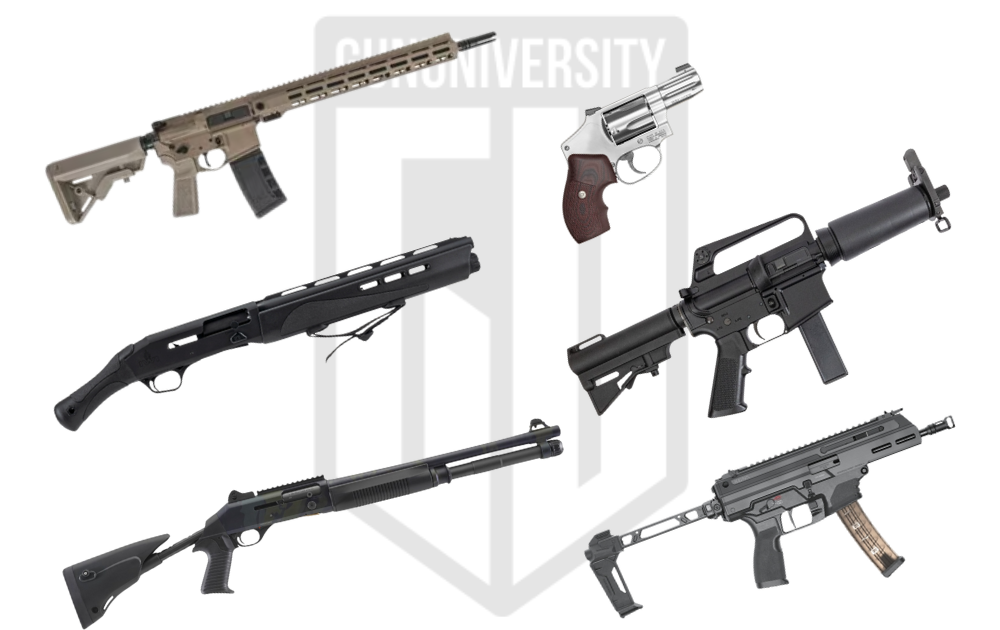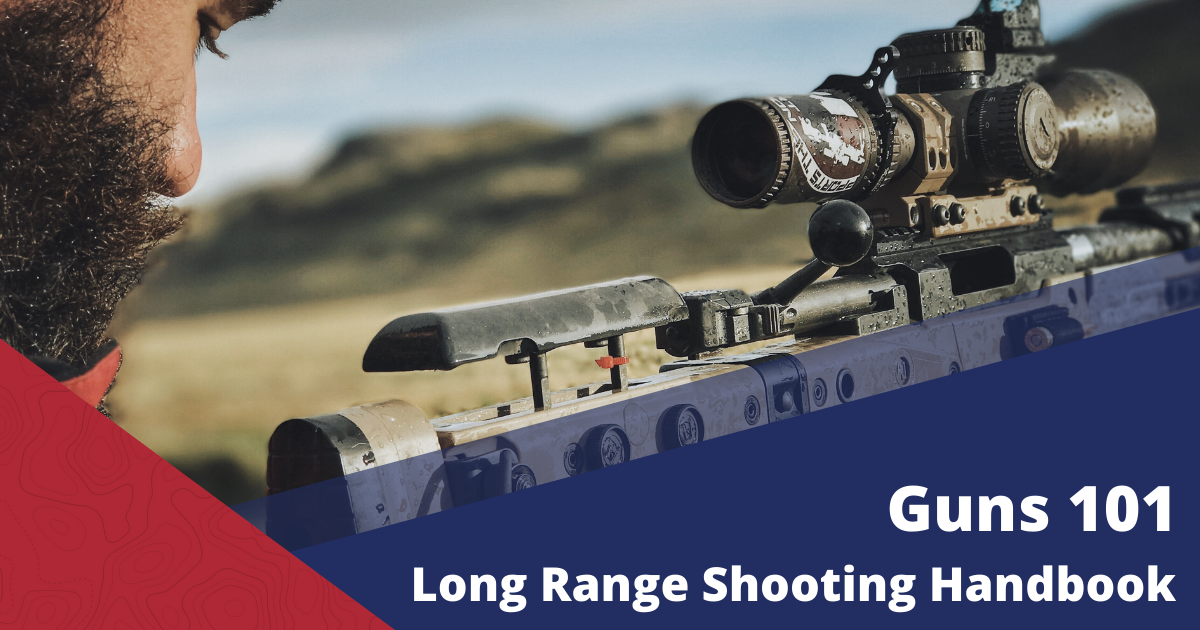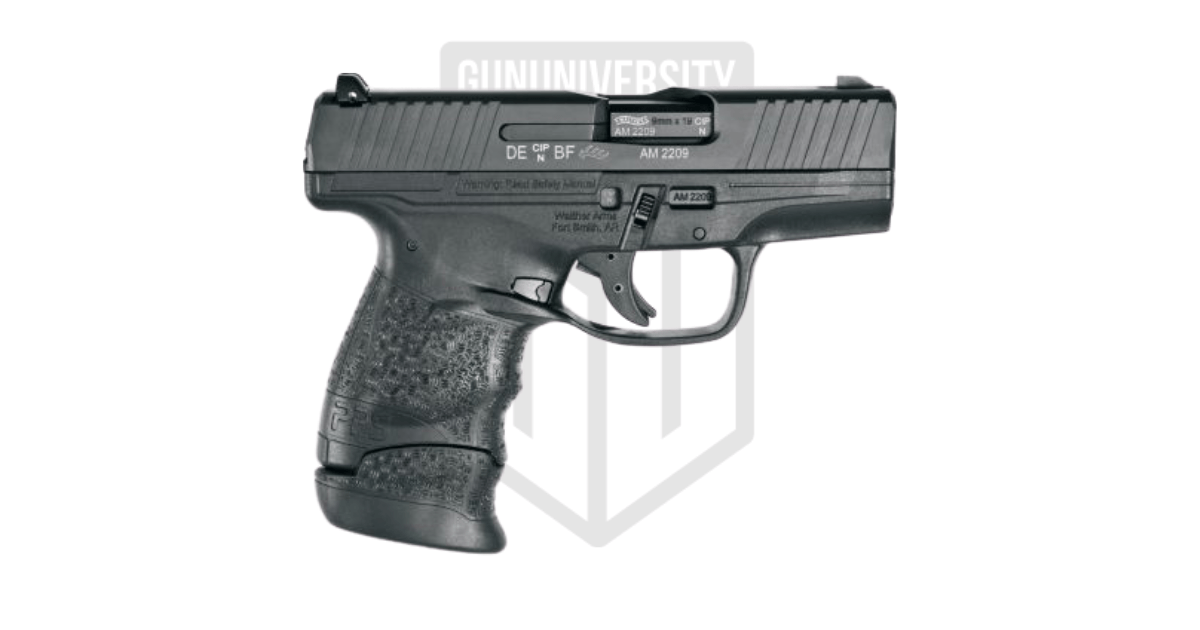300 Winchester Magnum vs 300 Winchester Short Magnum: Ammo Comparison
If you’re a fan of the 300 Winchester Magnum, you might have wondered where the 300 Winchester Short Magnum comes in. Is there a purpose for it? What specific applications does it have, and could one of them hold an appeal for you? It’s time for the showdown between 300 Winchester Magnum (Win, Win Mag, or WM) and 300 Winchester Short Magnum (WSM), and we’re here for it.
300 Win Mag vs. 300 WSM Specifications
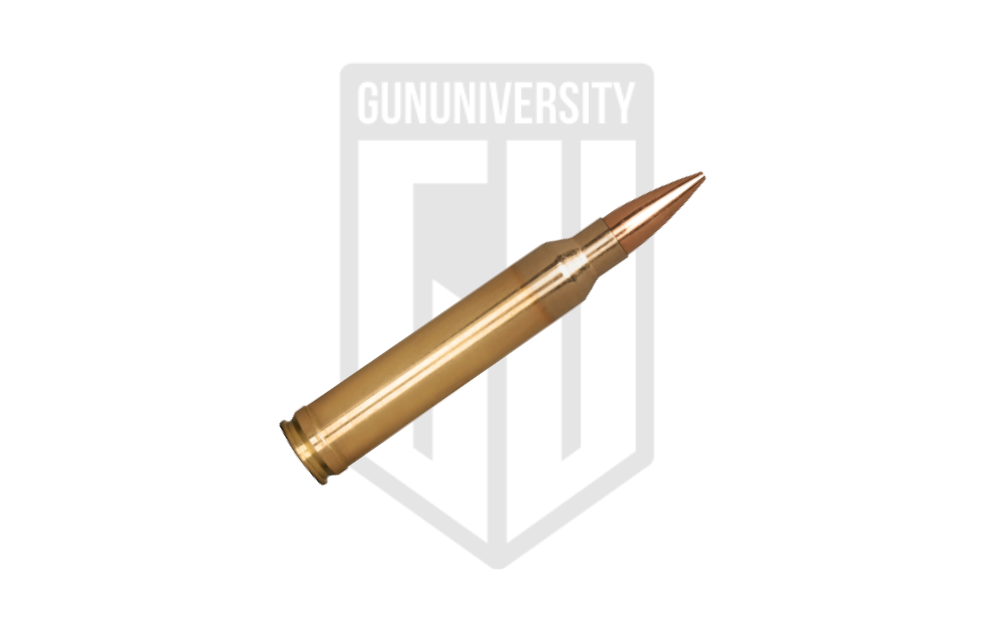
300 Winchester Magnum
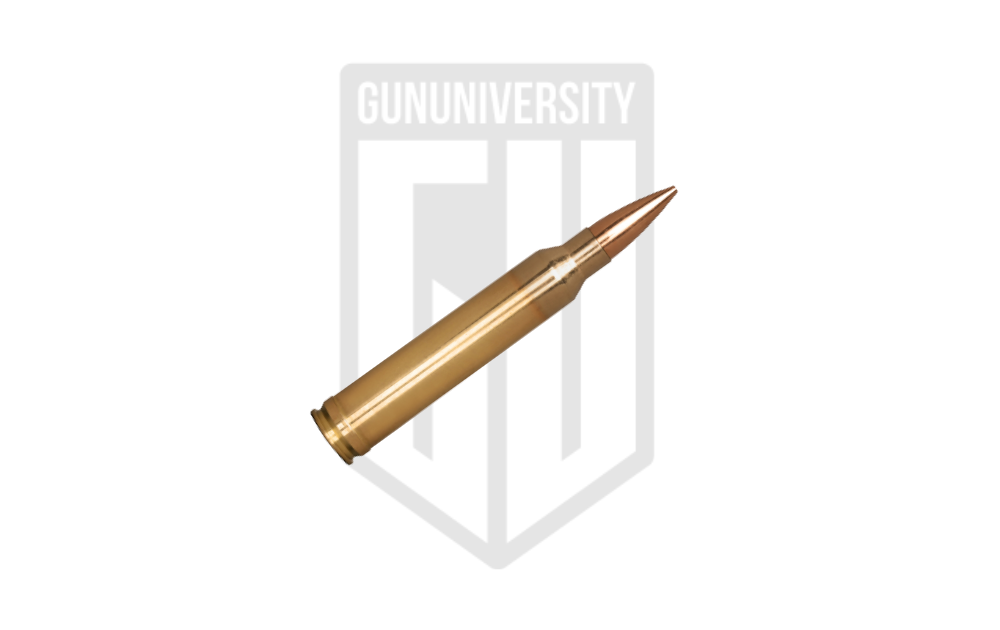
300 Winchester Short Magnum
Why compare 300 Win vs. 300 WSM?
The answer to why you’d compare 300 Win vs. 300 WSM is along the lines of “why wouldn’t you?” These two cartridges only have a single word’s difference in their designations. Each is .30 caliber, they share features, they’re both magnum, and they’re fun to shoot (at least they are if you enjoy magnums). Gun owners seem to fall in one of two camps when it comes to short magnums: love them or hate them. That makes comparing these two even better because it means taking a hard look at design and ballistics to figure out which one really is king.
In this comparison, it’s the 300 Win that’s the older of the two cartridges. For a cartridge, 300 WSM is relatively young and still gaining traction in certain circles. If you’re simply assuming 300 Win is superior just because it’s bigger and it’s been around longer, you might be in for a bit of a surprise. Who’s to say it isn’t 300 WSM that’s more versatile?
It’s the cartridge vs. cartridge face-off: 300 Win Mag vs. 300 WSM.
300 Win Mag Review
In the magnum world, 300 Win often reigns supreme. It’s been around for sixty years and it’s proven itself in every aspect, whether it be on steel, big game, or in combat. This is a cartridge with nothing to prove—unless you pause to compare it to a short magnum. That’s where things get interesting.
300 Win History and Purpose
It was 1963 when Winchester created 300 Winchester Magnum for hunting. The parent cartridge of the 300 WM is the 375 H&H Magnum, a cartridge with a dedicated following in its own right. Winchester’s Model 70 bolt-action rifle was the first to be chambered in 300 Win and it didn’t take long for the round to take off. While its rise to popularity might not have been as meteoric as hoped for, it did eventually earn a permanent place in countless gun safes.
They designed the 300 Win Mag a few short years after Winchester went on a bit of a magnum spree. In this time, they created the 264 Winchester Magnum, 338 Winchester Magnum, and 458 Winchester Magnum. Theories about why they created the 300 Win range from competition with the 7mm Remington Magnum to a demand for a better .30 caliber magnum. Whatever the case, it’s certainly surpassed the three Winchester-created magnums that were designed immediately prior to it coming into existence.
There’s simply no denying that 300 WM is a ridiculously versatile round. It’s offered in many loads and is more affordably priced than many magnums, and it’s favored by hunters and precision shooters alike. You might have a heavy precision rifle chambered in 300 Win or you might have an easily portable bolt-action you carry through the mountains chasing elk or bear. Yes, it’s a large cartridge, but you can be sure it’ll take care of business.
Pros and Cons of 300 Win Mag vs 300 WSM
- Track Record –300 Win has decades of fantastic performance backing it as a reliable, accurate round.
- Effective Range – The effective hunting range of 300 Win is further reaching than that of the 300 WSM.
- Case Capacity – 300 Win has more case capacity, which means it can push bullets down range at greater speeds than 300 WSM can.
- Recoil –The 300 Win has a bit more felt recoil than the average 300 WSM.
- Rifle Size – 300 Win rifles are frequently larger and more cumbersome than those chambered in 300 WSM.
- Barrel Life –The 300 Win can be hard on barrels, which definitely matters for high round count shooters.
Best Ammo for 300 Win
Whether you’re using your 300 Win for precision shooting or hunting, there are ammo choices aplenty. These are our picks for 300 Win:
Hunting Ammo

Barnes VOR-TX 300 Win 180 gr TTSX
Marketplace |
Cost Per Round |
| gun.deals | $2.13 |
| Firearms Depot | $2.64 |
| Guns.com | $2.84 |
Match Ammo
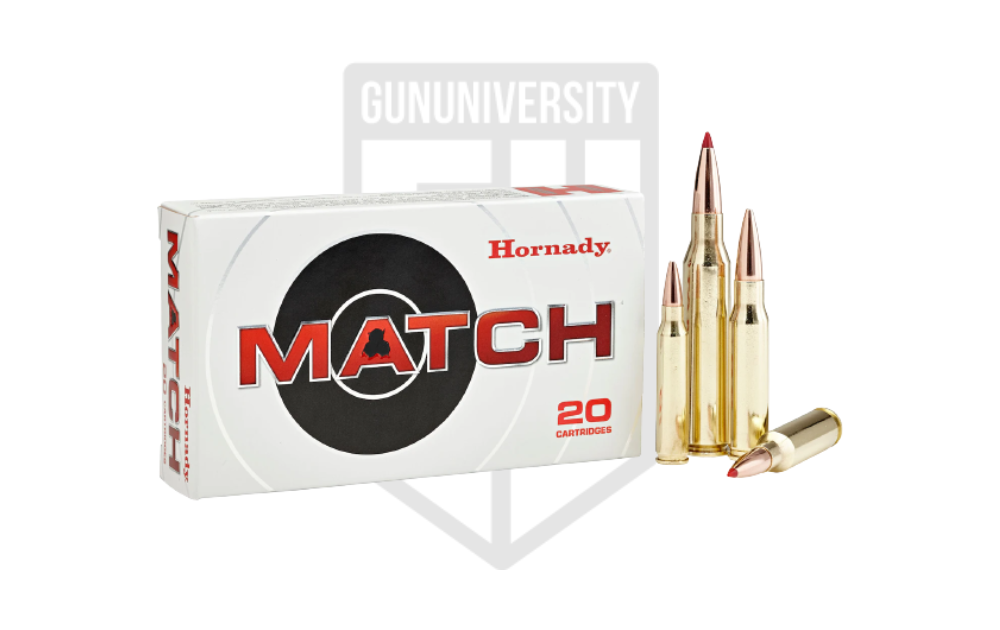
Hornady Match 300 Win 195 gr ELD
Marketplace |
Cost Per Round |
| gun.deals | $1.87 |
| Firearms Depot | $2.25 |
| Gritr Sports | $2.54 |
Practice Ammo
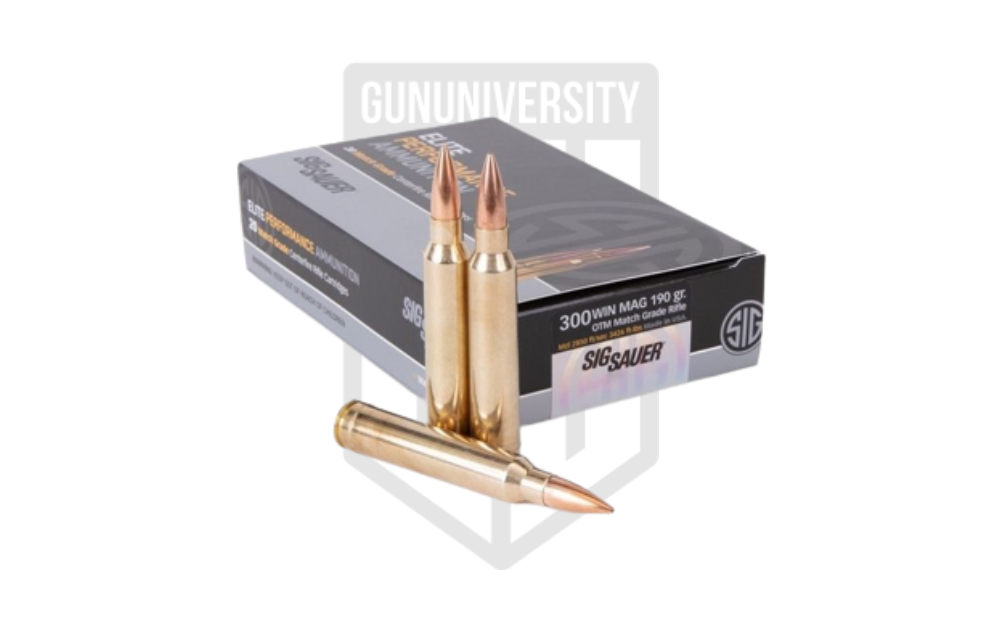
SIG Sauer Match Grade 190 grain OTM
Marketplace |
Cost Per Round |
| gun.deals | $1.09 |
| Firearms Depot | $2.08 |
| Gritr Sports | $2.35 |
300 WSM Review
The 300 WSM is a round favored by hunters in search of a lighter, more portable hunting rifle. After all, every ounce matters when you’re humping a rifle through rough terrain. If you use a 300 WSM you get that preferable magnum power without so much weight. Even the rounds take up less space in your pack.
300 WSM History and Purpose
This is a cartridge that’s rather new. Winchester officially announced it in 2001, meaning that at the time of this writing it’s only 22 years old. 404 Jeffrey seems to be its most likely parent case despite its similarities to 300 Win. When it comes right down to it the fact that it’s a short magnum makes it rather special on its own.
They created 300 WSM as a short—yet thick—cartridge capable of cycling in short action rifles. It isn’t the only short magnum designed by Winchester either. Winchester marketed several shorts and touted them as being just as good as their full-size brethren. It seems like 300 WSM gets the most attention, maybe because it’s a .30 cal, maybe because it’s seen as a cartridge used by truly discerning shooters.
It’s true that 300 WSM produces approximately 10 percent less felt recoil than 300 Win and also burns less powder. Also, rifles chambered in 300 WSM save a few ounces in overall weight. Whether that handful of ounces is vitally important to you comes down to personal preference. Yet, if the 300 WSM can do everything the 300 Win can do—only better—why not use it instead?
Pros and Cons of 300 WSM vs 300 Win Mag
- Recoil – 300 WSM produces less felt recoil than 300 Win. This can lead to a more pleasant shooting experience, especially for those who are recoil sensitive or smaller framed.
- Rifle Size – Rifles chambered in 300 WSM could be more than half a pound lighter than those chambered in 300 Win. Those ounces matter in the mountains and back country.
- Action Size – 300 WSM cycles in short action rifles, which is a huge pro for many shooters.
- Chamber Consistency –According to C.I.P., 300 WSM is a Delta L problem, meaning it just doesn’t work well in certain chambers. Some gun owners describe this is a one size doesn’t actually fit all issue.
- Effective Range – The effective range of 300 WSM is shorter than that of 300 Win.
- Trajectory –300 WSM doesn’t shoot as flat as 300 Win.
- Availability – Can be hard to find in stock
Best Ammo for 300 WSM
These are our top picks for 300 WSM. However, at time of writing, 300 WSM ammo is rather hard to find:
Hunting Ammo

Nosler Trophy Grade 300 WSM 180 grain AccuBond
Marketplace |
Cost Per Round |
| Gun.deals | $3.75 |
Match Ammo
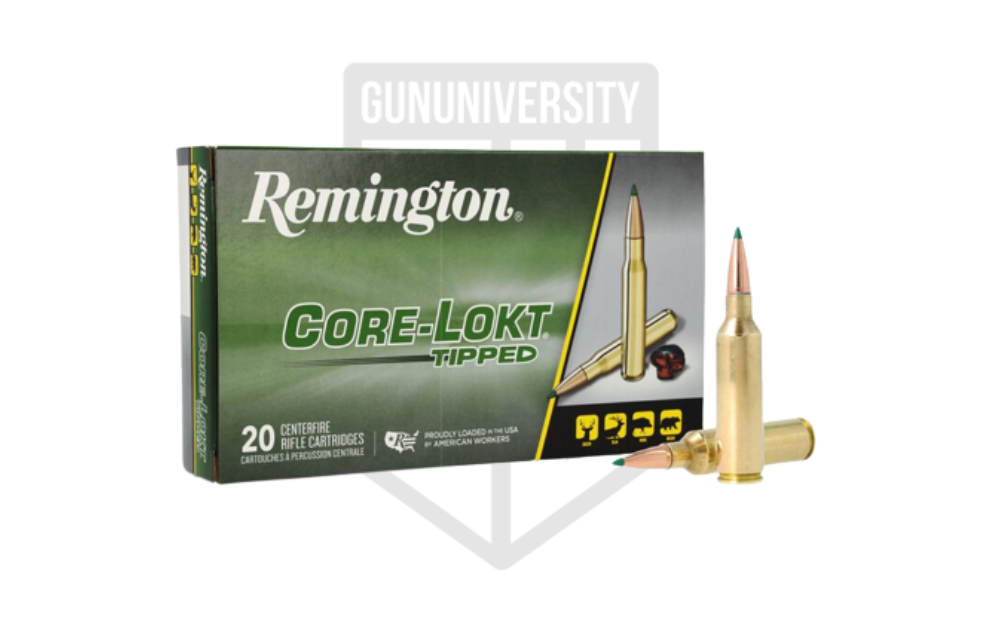
Remington Core-Lokt 300 WSM 150 gr Polymer Tipped
Marketplace |
Cost Per Round |
| Gun.deals | $2.59 |
Ballistics Comparison: 300 Win vs. 300 WSM
Now we get down to the truly fascinating part: ballistics. When it comes down to it, we choose our ammo based on our ballistic needs, and that means we have to understand it. Logically, we might understand 300 Win Mag supposedly produces more velocity thanks to its greater case capacity, and that 300 WSM doesn’t have as impressive of an effective range on big game. But what does that mean…really? Is it true?
To compare cartridges beyond 100 yards, we’re going to take a look at a few different loads. First, let’s consider Barnes VOR-TX 300 Win 180 grain TTSX with a ballistic coefficient of 0.484 against Remington Core-Lokt 300 WSM 150 grain Polymer Tipped with a ballistic coefficient of 0.415.
| Distance (yards) | Barnes VOR-TX 300 Win 180 grain TTSX Velocity (fps) | Barnes VOR-TX 300 Win 180 grain TTSX Energy (ft-lbs) | Remington Core-Lokt 300 WSM 150 grain Polymer Tipped Velocity (fps) | Remington Core-Lokt 300 WSM 150 grain Polymer Tipped Energy (ft-lbs) |
|---|---|---|---|---|
| 0 | 2960 | 3502 | 3340 | 3715 |
| 100 | 2766 | 3057 | 3093 | 3187 |
| 200 | 2580 | 2660 | 2860 | 2724 |
| 300 | 2401 | 2305 | 2639 | 2319 |
| 400 | 2230 | 1987 | 2428 | 1963 |
| 500 | 2065 | 1705 | 2227 | 1652 |
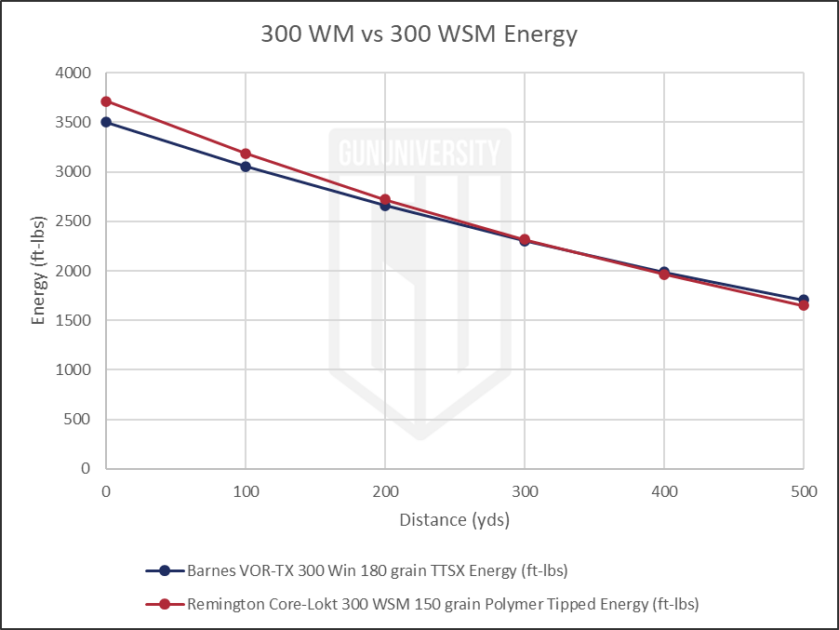
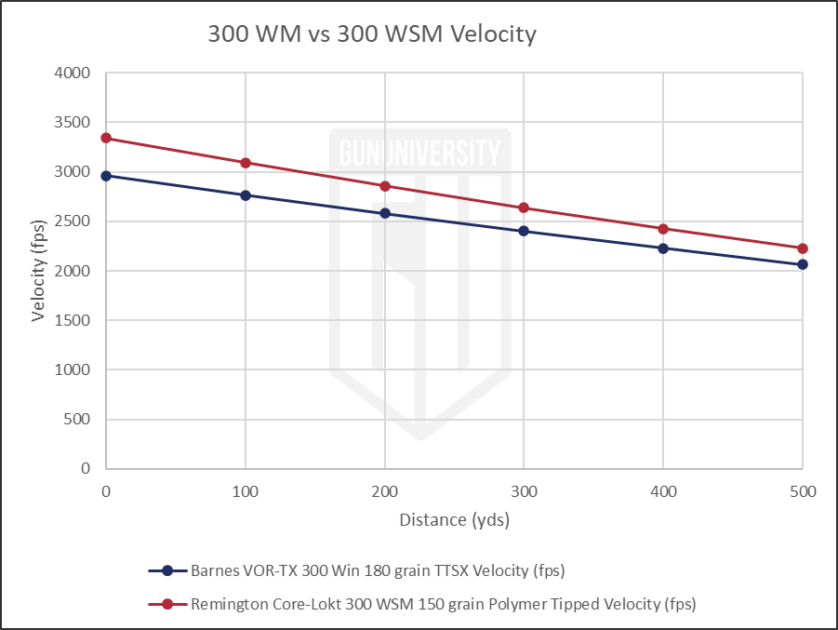
As soon as 300 WSM leaves the barrel of the gun, it’s producing a bit more velocity. This is likely thanks to the bullet, which is 150 grain compared to the 180 grain that this particular 300 WM is pushing down range. The 300 WSM is also delivering just a little more energy, something that sticks until around 400 yards, which is when energy starts dropping faster. The comparison of these two loads might be calling a few things you thought you knew about 300 WSM vs 300 Win into question.
If we change over to different loads and compare Hornady Match 300 Win 195 grain ELD Velocity with a ballistic coefficient of 0.584 and Nosler Trophy Grade 300 WSM 180 grain AccuBond with a ballistic coefficient of 0.507? Does it stay the same, or do the results look different?
| Distance (yards) | Hornady Match 300 Win 195 grain ELD Velocity (fps) | Hornady Match 300 Win 195 grain ELD Energy (ft-lbs) | Nosler Trophy Grade 300 WSM 180 grain AccuBond Velocity (fps) | Nosler Trophy Grade 300 WSM 180 grain AccuBond Energy (ft-lbs) |
|---|---|---|---|---|
| 0 | 2930 | 3718 | 2950 | 3479 |
| 100 | 2769 | 3321 | 2765 | 3055 |
| 200 | 2615 | 2960 | 2587 | 2675 |
| 300 | 2465 | 2631 | 2416 | 2334 |
| 400 | 2320 | 2331 | 2252 | 2027 |
| 500 | 2180 | 2059 | 2094 | 1752 |
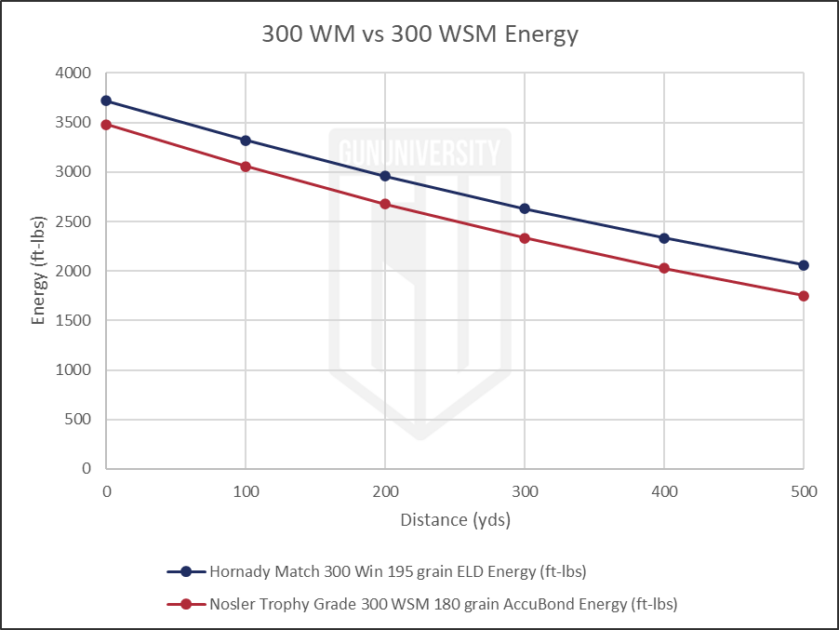
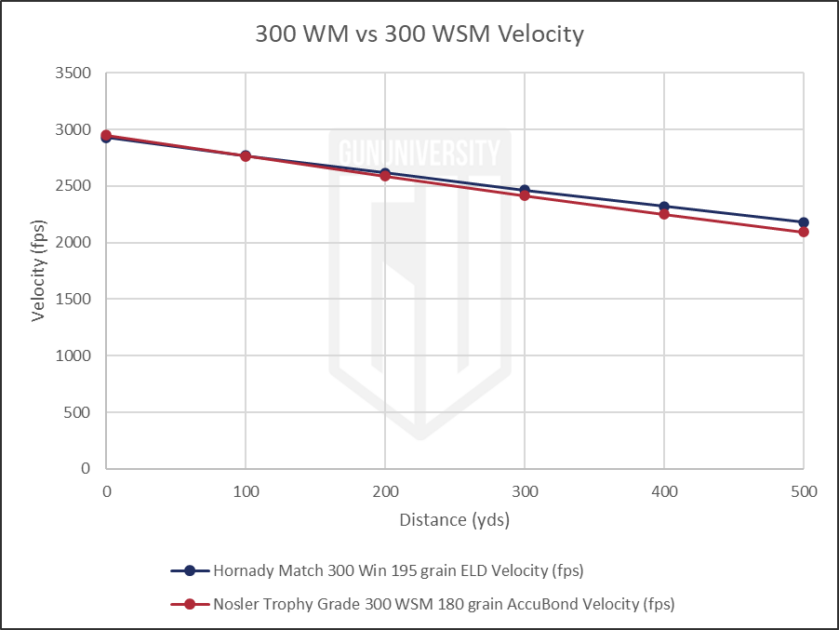
The differences between these two loads show a trend similar to the comparison before. Right around 300 to 400 yards, 300 WSM starts falling off faster than 300 Win. Let’s check out what that means for drop and drift.
| Distance (yards) | Hornady Match 300 Win 195 grain ELD Drop (inches) | Hornady Match 300 Win 195 grain ELD Wind Drift (inches) | Nosler Trophy Grade 300 WSM 180 grain AccuBond Drop (inches) | Nosler Trophy Grade 300 WSM 180 grain AccuBond Drift (inches) |
|---|---|---|---|---|
| 0 | -1.50 | 0.03 | -1.50 | 0.03 |
| 100 | 0.00 | 0.55 | 0.00 | 0.62 |
| 200 | -3.05 | 2.15 | -3.06 | 2.47 |
| 300 | -11.18 | 4.93 | -11.32 | 5.70 |
| 400 | -25.05 | 8.99 | -25.55 | 10.44 |
| 500 | -45.39 | 14.45 | -46.66 | 16.86 |
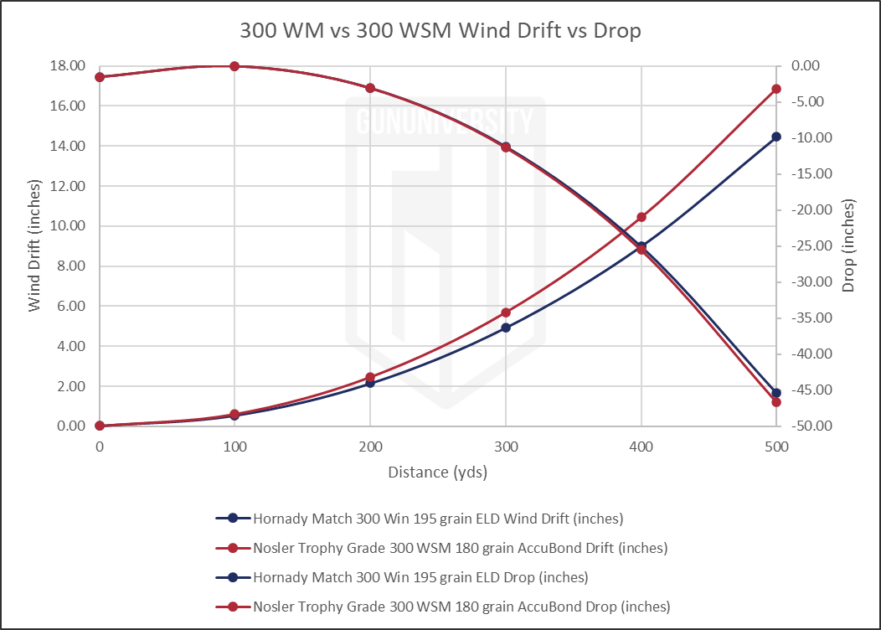
Once again, it seems like these two cartridges are neck and neck. The 300 Win manages to hang on longer than 300 WSM. If you start comparing ballistics beyond 500 yards, it becomes far more significant. But inside 500 yards, it does seem like the differences might accurately be described as negligible.
Is the 300 WSM poised to eventually unseat 300 Win, or is it a pretender to the magnum throne? Do those tiny differences in ballistics really matter?
Our Take – 300 Win vs. 300 WSM
You’re going to find out you have a lot more gun and ammo options in 300 Win. Not only has it been around far longer, but its following is more varied, whereas the 300 WSM is typically a little more niche. That’s not to say 300 WSM doesn’t have its place, because it definitely does, only that it probably shouldn’t have a stranglehold on your attention. Already have a 300 Win? You’re golden. Don’t have either, and you’re trying to choose? That’s where it gets a little stickier.
Recent Posts
December 20, 2025
December 15, 2025
December 15, 2025
December 12, 2025


